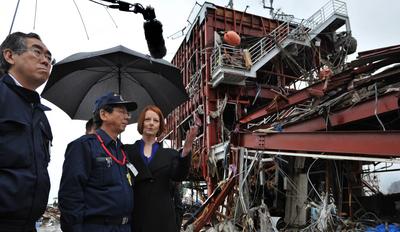Importantly, the Joint Statement also acknowledged the key link between trade liberalisation and economic growth … It states, ‘The two Prime Ministers recognised that trade and investment liberalisation would be vital to…economic growth in the two countries’. The link between trade liberalisation and economic growth is the most important reason why the Kan administration has adopted a pro-active free trade agenda.
The Kan administration’s ‘New Growth Strategy’ of June 2010 committed it to considering ‘how to pursue economic partnerships with Asian countries and other major countries and regions’, and to creating a Free Trade Area of the Asia-Pacific (FTAAP) by 2020 as a way of incorporating Asian growth.
The ‘Basic Policy on Comprehensive Economic Partnerships’ of November 2010 continued the same narrative, linking Japan’s economic growth to deepening ‘economic relationships with Asian and emerging countries, whose markets are expected to grow, and with Western and resource-rich countries’. At the cabinet meeting that formally decided the Basic Policy, Prime Minister Kan emphasised the importance of trade liberalisation for spurring economic growth. In his view, the policy marked the beginning of a major strategy to create a new prosperity for Japan, one that would ‘definitely bring benefits’.
Recommendations from the party to the cabinet about Japan’s participation in the TPP also acknowledged that ‘entry into the TPP would enable Japan to “tap the Asia-Pacific region’s growth and use it as a catalyst to revitalize its own economy”’.
The Minister of State for National Policy, Gemba Kōichirō, later remarked, ‘Today Japan requires a strategy that will allow it to incorporate the demand arising from the enormous population of the Asian market”. He specifically flagged the relevance of the TPP in February, stating that that ‘“An extremely important vehicle to ensure Japan’s economic growth is free trade agreements. Japanese people should once again look overseas”…adding that it is essential for the country to incorporate the energy of Asian countries to seek growth on its own’.
These statements from the Kan administration implicitly reflect its acceptance of the economists’ creed that trade liberalisation leads to a net gain in economic welfare. More obviously, they reflect the consensus amongst Japanese business organisations and the economic media that it is imperative to harness the forces of trade liberalisation to breathe new life into Japan’s moribund economy. Former chairman of the Japan Association of Corporate Executives (JACE), Sakurai Masamitsu, described his country’s growth strategy as ‘Opening up the country and then welcoming demand from Asia and the world’s growth markets’.
These views also reflect Japan’s growing reliance on trade with Asia. Statistics for 2010 released by the Finance Ministry in January 2011 reveal that 51 per cent of Japan’s total exports and imports are now with the rest of Asia, exceeding 50 per cent for the first time. Japan’s No. 1 trading partner is China, but Japanese companies are also increasingly using ASEAN nations as a base for exporting to countries outside the region.
Yet structural reform of the economy, including agriculture, is not regarded as a means towards economic growth by the Kan administration, nor is structural reform a goal of the DPJ’s increasingly pro-active free trade policy. As noted elsewhere, the DPJ is simply not the party of structural reform in the agricultural sector. Economic reform only figures in so far as it may be required to facilitate trade liberalisation. In short, the end and means have been reversed: economic reform is now a means towards trade liberalisation.
At most, the government’s plan for agricultural reform envisages some consolidation of farmland, relaxation of restrictions on corporate entry into agriculture and promotion of farm exports. At the same time, the Kan administration is proposing on-going government intervention to support agriculture in order to facilitate trade liberalisation agreements. In particular it envisages the construction of a comprehensive safety net of direct income subsidies to protect all farmers (including inefficient ones) from the downside of increased market access. In Kan’s mind, the safety net is an integral aspect of opening up the country. He declared at a meeting of cabinet ministers involved in FTA policy, ‘It is essential to prepare substantial safety nets on various areas, including agriculture, in opening up our country’. The safety net will in fact impede structural reform of agriculture, although it will make agricultural trade liberalisation more politically feasible.
The switch of ends and means also affects timing. Domestic reforms have to be carried out first, before substantial trade liberalisation can be contemplated, particularly for agriculture. For example, the commitment to promoting EPAs in the Basic Policy is accompanied by a simultaneous commitment to ‘first press ahead with fundamental domestic reforms in order to strengthen the competitiveness it will need for economic partnerships of this kind…. In particular, agriculture is the field most likely to be affected by trade liberalization….the Government of Japan…will first promote appropriate domestic reforms with respect to areas of the agricultural industry’ (emphasis added).
What this means in practice is that there will be no comprehensive market opening before agriculture is sufficiently competitive to withstand it. The envisaged reforms will take 5-10 years to bear fruit, and it will be crucial, therefore, to slow down the pace of tariff reduction so that this process will not leave Japanese farm households exposed.
This approach to agricultural reform and trade liberalisation crucially affects the Kan administration’s ability to conclude FTAs under consideration successfully, including the TPP. The risks are high that the Kan government’s trade policy will end up merely as a statement of rhetorical goals combined with minimalist concessions at the negotiating table.
Aurelia George Mulgan is Professor of Politics at the University of New South Wales, Australian Defence Force Academy.

